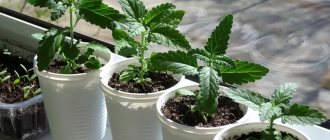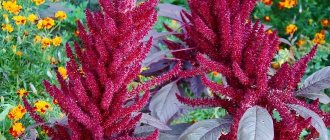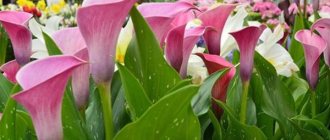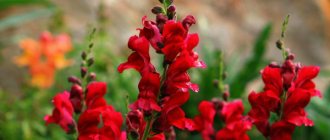Ageratum is a flowering plant from the Asteraceae family. Under natural conditions, it grows in the eastern part of India, North and Central America. “Ageratos” translated from Greek means “ageless.” This is due to the peculiarity of cut flowers not to wither for a long time.
In the 19th century, ageratum came to Europe, and since then has been widely cultivated by flower growers. The plant is loved by many for its spectacular fluffy inflorescences, reminiscent of pompoms, which are painted in different shades. Ageratum can become a decoration for any flower bed and garden plot. It is easy to care for and reproduces well using seeds.
Ageratum: types and varieties for open ground
About 60 types of crops grow in nature. Shrubs are tall (about 60 cm in height), medium tall (up to 30 cm), and dwarf (10-15 cm). But only some types of ageratum and their varieties are cultivated.
Blue or Blue Mink
Low branched shrub up to 25 cm in height. The inflorescences are lush, soft blue, reminiscent of mink fur. The diameter of the inflorescences is 5-8 cm.
Mexican or Houston
Compact spherical bush. Its height can vary between 10-60 cm, depending on the variety. The leaves are diamond-shaped or oval and may have jagged edges. The flowers are small, collected in small inflorescences-baskets.
Popular varieties of Mexican ageratum:
- Alba,
- Azur Pearl,
- Faye Pink,
- Blue Mink,
- Blue Bouquet,
- Blausternchen.
Ageratum flower - description
The ageratum flower is a perennial subshrub or herbaceous plant with numerous branched, erect or ascending pubescent stems from 10 to 50 cm in height. The alternate, jagged along the edges of the leaves of ageratum have a rhombic, oval or triangular shape; the upper ones are located on petioles, the lower ones are almost sessile. Baskets with a diameter of 1-1.5 cm of fragrant bisexual tubular flowers form complex corymbs up to 10 cm in diameter. The decorative effect of the inflorescences is achieved due to the two-lobed stigmas, which usually rise strongly above the perianth, and the baskets appear fluffy. Ageratums bloom profusely from the beginning of summer until the first cold weather. Low-growing representatives of the genus form flower shoots in several tiers, and in taller ageratums the flower stalks are located at the same level. At the beginning of September, the fruits of ageratum ripen - pentagonal achenes with a tuft, which contain seeds that remain viable for up to three years.
Some types of ageratum are toxic, and the most commonly grown ageratum, Houston's (Houston's), has carcinogenic properties and causes liver disease.
Growing from seeds to seedlings
Although ageratum is considered a perennial, in temperate climates it is grown as an annual and replanted every year. The best way to propagate a plant is by seed. From one bush you can collect up to 10 thousand seeds. They can be sown directly on the site or grown as seedlings. The best time to plant seeds for seedlings is the second half of March. But if you want to shift the flowering time, you can sow later.
Soil and container
For sowing, prepare shallow containers or boxes with drainage holes. Fill them with a mixture of equal parts of peat, sand and humus. The soil should first be disinfected with a solution of potassium permanganate and moistened.
Ageratum seeds are very small. To make it more convenient to sow them, it is recommended to mix them with sand. Distribute over the surface of the soil, press lightly. Spray with water using a spray bottle. Cover the top of the container with film or glass to avoid excessive evaporation of moisture. From time to time the cover must be removed to ventilate and moisten the soil.
Seedling care
For normal development of seedlings, it is necessary to keep them at a temperature of +20-25°C. Before germination, humidity should be at least 90%. Lighting does not play a fundamental role for seed germination. From the moment the gatherings appear, the shelter must be removed.
At the stage of opening the cotyledons and growing roots, it is important to keep the soil moist at all times. But you can’t flood the crops. When the shoots appear, they need to be provided with good lighting. After 3 weeks, the plant should already have 3 true leaves. Before planting on the site, seedlings need to be hardened off.
Picking
You can plant seedlings after the first pair of leaves appear. It is important not to delay this. If the plants are not planted in time, their roots will become intertwined and some of the seedlings will simply die. The first picking is carried out in the same box, planting the plants at a greater distance from each other. The seedlings are planted again after 2 weeks into separate cups or pots.
If you plant the seeds in separate peat pots, picking can be avoided.
Transplanting
The timing of planting seedlings in open ground may vary depending on the climate and region. In mid-latitudes, this can be done from mid-May, if the weather is finally warm outside and the soil is well warmed up.
Choose a well-lit area for planting seedlings.
Dig holes for the required number of plants. If the ageratum is tall, then the distance between the holes should be 20-30 cm; for low-growing varieties, 15 cm is enough. Water the holes and let it soak. Transfer the seedlings into them along with a lump of earth. The planting depth should be the same as it was in the pot. Warning! Under no circumstances should you fertilize the soil with manure. This can lead to the death of the culture.
Popular varieties with photos
Flower growers and landscape designers prefer blue and purple varieties of ageratum, since the flowers of these shades do not fade in the sun, unlike white and pink ones. Most often they grow the following plant varieties in their plots:
- Blue mink.
The plant is a small bush with bright blue flowers and strong shoots. Flowering of this variety begins at the beginning of the summer and lasts until frost.
- Blue ball.
This miniature variety of ageratum reaches a height of 13 cm. The plant is suitable for growing in regions with arid climates. During flowering, it produces numerous lilac-blue flowers.
- Blue muff.
The flowers of this variety of ageratum are deep blue. They are represented by fluffy baskets that completely cover the stems of the plant.
- Blue fairy tale.
This variety is valued for its long and abundant flowering, during which flowers of a lilac-blue hue appear. The plant is resistant to drought and direct sunlight.
- Bonjour.
The mixture of Bonjour varieties is also distinguished by long and abundant flowering. Small fragrant flowers of various shades of this plant are collected in large corymbose inflorescences.
Planting seeds in open ground
Ageratum can be sown directly on the site, if the climate permits. But flowering in such cases will occur later than with the seedling method of growing the crop.
Sowing time
The plant can be sown on the site when warm weather has completely established itself and there is no risk of night frosts. In temperate latitudes it is better to do this in mid-May. At first, it is still recommended to cover the area with crops at night with agrofibre if there is a significant difference between day and night temperatures.
Choice of location and lighting
The main requirement of ageratum for normal development is bright lighting. The flower can retain its decorative appearance only in sunny areas. Even a slight shadow leads to stretching of the stems, smaller leaves, and less lush flowering.
Therefore, the plant should be planted only in sunny areas, no matter whether it is a border, a border or a garden pot.
Priming
Ageratum has no special requirements for soil. Only very rocky and damp soil is not suitable for it. It is preferable to plant the plant in a nutrient substrate with neutral acidity. It must not be oversaturated with humus. This will encourage green growth and will have a negative effect on flowering.
Landing rules
Prepare the area in advance. Remove all weeds and dig up the soil. If its acidity is high, you can add lime. Make shallow furrows and sow seeds mixed with sand in them (for more uniform sowing). Sprinkle a thin layer of soil on top and water it. To make seedlings appear faster, it is better to create greenhouse conditions for the crops and cover them with polyethylene. When the shoots appear, they need to be thinned out. After a pair of true leaves appear, plant the seedlings at a longer distance from each other.
Ageratum at home
Ageratum can be grown at home. They choose spacious pots that provide good drainage. In summer they are taken out onto the balcony or secured under the windows. When it’s cold outside, ageratum pleases with its luxurious flowering continuously.
It is necessary to adhere to simple rules so that ageratum blooms for many years, maintaining its decorative effect:
- Ageratum is best grown on a windowsill on the south side, where there is more light and warmth.
- Watering is carried out at the root, it is impossible to over-water. It is better to water the flowers in the morning in small portions every day.
- It is better to purchase soil for seedlings at a garden store, then it will be rich in microelements and organic matter. In addition, such soil is looser, due to which oxygen easily flows to the root system of the plant.
- Ageratum should be fed at least 2 times a year with complex fertilizers.
- When the flower grows, it is better to divide it and transplant it into a spacious pot.
Outdoor care
There are no particular difficulties when growing ageratum. It is enough to provide basic care, as for other flowering plants.
Watering
The bush will be more lush if it is watered regularly. The soil should always remain evenly moist. But you should not allow water to stagnate in the hole. This can cause the plant's roots to rot. After watering, the soil under the ageratum needs to be loosened.
Feeding and fertilizer
During the entire growing season, the crop is fertilized 3 times. It is better to use complex mineral fertilizers for flowering plants. The dosage should be taken 2 times less than indicated in the instructions. Excess minerals will stimulate the growth of green mass, and the flowers will be small and inconspicuous. Organic fertilizers have the same effect. Therefore, it is better to avoid them.
Trimming and pinching
Ageratum needs to pick off faded inflorescences. This stimulates the formation of new flowers. Even if the bush is cut by more than half, in a short time it will restore its decorative properties. You can pinch the shoots of the plant even during the flowering period. Pinching is done over the top 3-4 leaves. You can form a beautiful bush according to your taste.
Weeding
A mandatory step in proper ageratum care is regular weed removal. If you do not get rid of them, they will take nutrients from the soil and interfere with the normal development of the flower. Weeds are especially harmful to low-growing species. During weeding, it is necessary to loosen the soil to provide air access to the roots.
Ageratum plant care
Despite the fact that ageratum is considered an unpretentious plant, it still needs to be cared for. Then it will delight with bright flowering for a long time.
Watering
Thanks to its well-developed root system, ageratum receives the required amount of moisture from the soil. Therefore, watering can be done every 3 weeks, but at least once a month. in hot weather, watering should be more frequent.
Top dressing
Mineral and organic fertilizers are used to feed the flower. Gardeners also often use complex fertilizers.
Fertilizing is applied every 20 days. First apply a small dose of fertilizer, otherwise flowering may slow down due to an excess of fertilizing.
Feeding options:
- “Uniflor Bud” - for watering, dissolve 2 teaspoons of fertilizer in 10 liters of water.
- “FlorHumate Flower” - water with a solution of 100 ml of fertilizer in 10 liters of water.
- “Florist - for buds” - dissolve 5 ml of fertilizer in 10 liters of water and water.
Important! Experienced gardeners do not recommend using manure and other organic fertilizers to fertilize the soil. It can destroy the plant.
Weeding and loosening
Weeding and loosening of bushes is carried out immediately after watering them. Weeds can choke the growth of flowers and negatively affect the abundance of their flowering. And loosening the soil is necessary so that oxygen can easily reach the roots. The main thing is to loosen only the very surface of the soil.
Also, loosened soil allows moisture to pass through faster and prevents it from stagnating and blooming.
Trimming
In order for the bushes to be lush and bloom beautifully, they must be trimmed periodically. During pruning, leave 4 internodes to speed up flower development.
Before the first frost, the flowers can be transplanted into separate pots and grown at home.
With proper care, ageratum will bloom all winter.
Important! In the spring, a plant that has overwintered in pots can be replanted in open ground or the flower can be cut into cuttings to rejuvenate it.
Cuttings
Ageratum can be propagated by cuttings. Especially if you want to grow a branchy and not tall plant. The cutting method can also be used for breeding hybrid varieties, since they do not propagate by seeds.
You can grow ageratum using cuttings like this:
- In the fall, before the onset of frost, the ageratum is transplanted into a pot and brought into the house.
- Cuttings are taken in spring. They are taken from side shoots. Several cuttings can be taken from one flower. An incision is made just below the kidney, since in this place the tissues contain a special substance that is less susceptible to fungus. Thanks to this, the flower will not die and will not get sick.
- The cuttings are cut 5 cm long and planted in a mini greenhouse.
The cuttings take root quickly, after which they are planted in open ground, just like seedlings.
Protection from pests and diseases
Although ageratum is unpretentious, it can be susceptible to various diseases. With excess moisture and cold air, it is affected by root rot. There is no point in fighting her. Affected plants are dug up and removed to prevent the disease from spreading further.
The flower can also be affected by cucumber mosaic. The shoots become glassy, and yellow spots appear on the leaf blades. The buds do not bloom. Diseased areas of the plant must be removed. And treat the remaining ones with a fungicide or a decoction of tansy and wormwood.
Common ageratum pests:
- spider mite;
- nematode;
- whitefly
You can destroy parasites using insecticides:
- Intavir;
- Aktara;
- Karbofos.
When to sow ageratum
Ageratum can be propagated from seeds at home; it can also be sown in the soil; when it gets warmer, it reproduces well by self-seeding. This small ornamental plant is sensitive to negative temperatures. It is important to time planting after the last frost date, given that it takes approximately 10 weeks to prepare seedlings. Ageratum seeds are sown in seedling boxes in February - March for cultivation in greenhouses or at home.
In the southern regions, almost all annual flowers can be sown directly into flower beds. In the Middle Zone, regions with a temperate climate, and the Moscow region, it is better to sow seeds on a windowsill or in a warm greenhouse in March, because the soil in the garden will remain too cold for a long time and therefore unsuitable for sowing. Although in the Moscow region you can sow ageratum directly into the ground at the end of April or early May, you need to install a small film greenhouse over the bed.
In the Leningrad region, seedlings are sowed in April, in colder regions (Ural, Siberia) - at the end of April, taking into account the expected date of planting in flower beds - June.
There are many advantages to sowing ageratum for seedlings earlier:
- Flowering accelerates - plants planted in the garden in May are already quite large and bloom 1-2 months earlier than those sown directly into the ground.
- Fewer seeds are used - when sowing in pots or trays, each seedling is used, and in multi-pallets, only 2 seeds are sown per cell.
- By growing our own seedlings in early spring, we have complete control over what has grown and what has not, and can plan exactly what to plant in the garden.
When to sow ageratum for seedlings according to the Lunar calendar
The lunar calendar is simply an indispensable thing for a gardener or gardener; with its help you can understand what day is best to plant a particular plant. Fortunately, ageratum is no exception to this rule.
Favorable days for planting ageratum seedlings can also be determined by the lunar calendar.
Favorable days for sowing
Ageratum is completely easy to care for, so it can be grown both at home and in open ground. But all sowing and transplanting procedures must be carried out in accordance with the Lunar calendar.
The most favorable days for sowing:
- In January - 1, 5, 9, 11, 16-19, 22, 27-29;
- In February - 1-4, 6, 7, 12-14, 20, 24, 25, 28;
- In March - 3-6, 11-13, 17, 18, 22, 27, 28;
- In April - 1, 2, 7-10, 13, 18, 19, 24, 28, 29;
- In May - 5-7, 11, 12, 15, 16, 20, 25, 26.
If you want to succeed, then any vegetable and flower crop must be sown at the right time - not too late and not too early.
How to plant ageratum seedlings correctly
Before you start seedlings, you need to know a few tricks and secrets that will help you grow large and healthy flowers.
Below we will describe the steps by following which you can decorate your garden with any type of ageratum.
Seed selection and preparation
Seeds must be purchased from a trusted manufacturer; if the packaging is damaged, this should scare you; all storage and transportation rules must be followed.
The most accurate recommendations are written on the packaging; the manufacturer writes planting dates and care tips.
Ageratum seeds do not need any pre-treatment, but you can place them in a solution of a growth stimulator, then the seedlings will be stronger.
You can also use natural substances, such as aloe vera, to treat seeds. You need to dilute it with water in a ratio of 1 to 1 and soak the seeds there for 24 hours.
Soil selection and preparation
The soil for ageratum should be well-permeable to air and water, and should also be light and loose. If you purchased the substrate in a store, be sure to add washed sand there.
To make your own soil, you will need:
- Peat
- Humus
- Sand
After you have mixed all the ingredients, it is recommended to steam the mixture in a double boiler for an hour
Selection of capacity
It is most convenient to sow ageratum seeds in a large plastic container, but the depth should be no more than 10 cm.
Drainage holes need to be made at the bottom, this will prevent moisture stagnation and root rotting.
Direct sowing
Sowing ageratum is an incredibly simple procedure that a gardener of any level can do. Step-by-step instructions for sowing seeds for seedlings:
- Drainage
Before starting, be sure to place drainage at the bottom of the container, so excess water will not stagnate;
The drainage layer should not be too large, 1-2 cm is enough.
- The soil
Place the soil so that there are no voids, and do not fill the container to the very brim;
- Watering
It is best to water the seeds using a sprayer, so they will not spread over the surface.
At this and at any other stage of planting, you must use only clean and infused water; you cannot use tap water.
- Sowing
Sowing seeds is best done using tweezers, and the distance between them should not be more than 2 cm.
But you can sow by hand, in this case you only need to add salt to the seeds, this is quite acceptable;
Sowing should only be superficial; there is no need to cover the seeds with soil.
- Watering
At this stage, you need to water only with a sprayer, otherwise the stream of water will simply wash away all the seeds on the surface;
- Creating a greenhouse effect
After all the basic procedures, cover the container with a plastic bag or lid, this is necessary for seed germination;
- Transfer
You need to move the container to a place with a temperature of 22-23 degrees, this is the optimal temperature for seed germination.
Care for ageratum seedlings
- The mini-greenhouse that you made needs to be ventilated during the day, 2-3 times for 20 minutes will be enough;
- Think about the temperature regime, the optimal temperature for germination of sprouts is 22-23 degrees, after germination it is better to reduce the temperature by 1-2 degrees;
- Drying out the soil is not permissible; monitor the soil moisture;
- When the first shoots appear, it is necessary to move the container to a sunny place.
Ageratum pick
The time for picking ageratum occurs when the sprouts have two green leaves.
In order to properly transplant ageratum, you need to follow these steps:
- Water the sprouts before you plan to pick;
- Make a small depression in the center of the new container;
- With special care, pick up the sprout along with a small piece of soil and plant it in the hole;
- Cover the hole with soil and compact it, and then water it.
Collecting seeds from the site
If desired, ageratum seeds can be prepared yourself. This is quite easy to do. The main condition for obtaining viable seeds is pollination of the flower. Ageratum is a good honey plant, insects love it very much, so when growing in open ground you don’t have to worry about this.
Seeds can be collected immediately after flowering ends. Due to the long flowering of ageratum, seed ripening occurs gradually. Faded baskets are trimmed and dried. Seed material is collected from both main and daughter shoots. Collection is carried out in dry sunny weather.
Ripe seeds are light brown in color and remain viable for three years. Seeds should be stored in paper or fabric bags.
If different varieties of ageratum are planted nearby, then as a result of cross-pollination the purity of the variety is not preserved.
When to plant depending on the region
The climatic zones of Russia are quite extensive. Weather conditions in different parts of it vary significantly. Therefore, the timing of sowing ageratum and planting its seedlings in different regions varies significantly.
In Moscow and Moscow region
Garden seeds are sown in mid-March. Grown seedlings are transplanted into the ground in May, when the average daily temperature is 22°C. Planting dates can be adjusted taking into account frosts.
In the middle zone
For the regions of Central Russia, it is recommended to plant in March. Seedlings are planted after night frosts have passed in early to mid-May.
In the Urals
In this part of Russia, the acceptable time for sowing seeds of the Ageratum flower crop is mid-May to early May. Planting in flower beds is carried out 50-60 days after emergence.
In Siberia
In Siberian regions, frosts may set in until the beginning of June. Taking this into account, flower seeds are sown in mid-April. Grown plants are planted in late May to early June.
In the Leningrad region
Just like in Siberia, in the Leningrad region it is better to start the sowing date in mid-April. Seedlings are planted in flower beds at the end of May, but weather conditions are taken into account.











